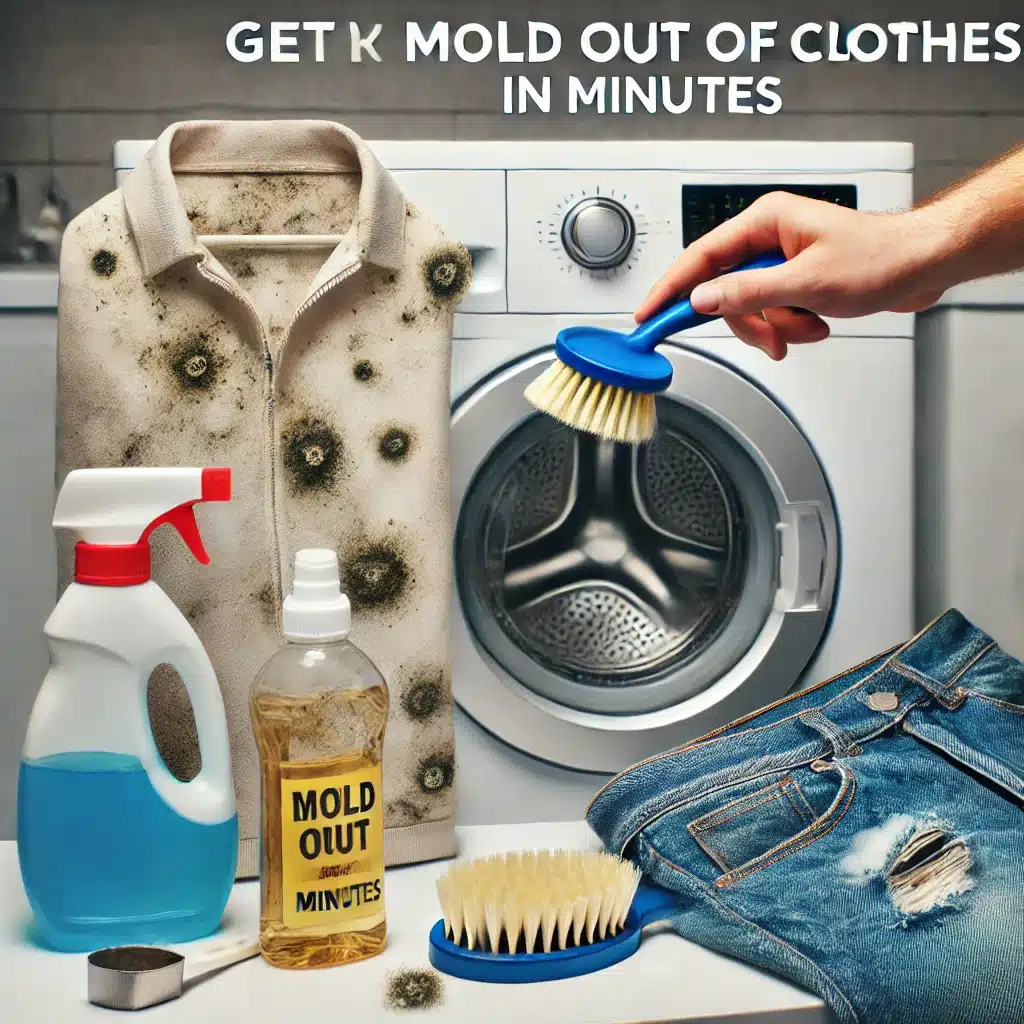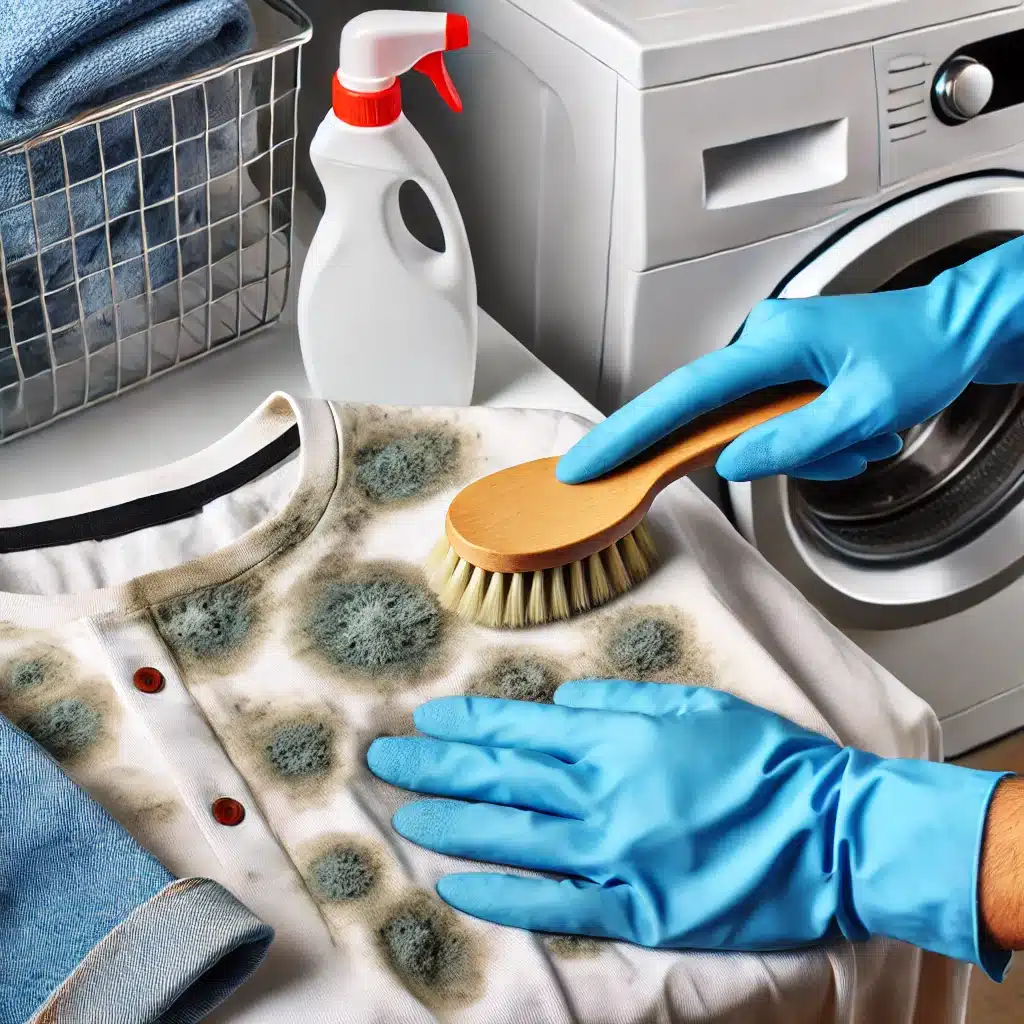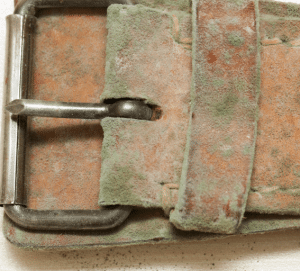Knowing how to get mold out of clothes is crucial when you find yourself dealing with stubborn stains and unpleasant odors. Whether you’ve accidentally left wet laundry sitting too long or stored clothes in a damp area, mold can quickly become a frustrating issue. But with the right approach, you can eliminate mold from your fabrics in just a few minutes.

In this blog, we will be sharing expert tips that make removing mold from clothes simple and effective. You won’t need harsh chemicals or specialized cleaners, just some everyday household items and a bit of patience. With these easy-to-follow steps, your clothes will be back to smelling fresh and looking good as new in no time.
Before you throw away moldy clothes or pay for expensive cleaning services, try these easy tips for how to get mold out of clothes quickly. By the end of this post, you’ll know how to remove even the toughest mold stains and keep your clothes looking and smelling fresh!
Understanding the Dangers of Mold on Clothes
Mold is a type of fungus that thrives in warm, damp environments, and your clothes provide the perfect breeding ground for these pesky spores. While some molds are harmless, others can be toxic and pose serious health risks, especially for individuals with compromised immune systems, respiratory conditions, or allergies.
When mold grows on clothes, it can cause discoloration, and musty odors, and even weaken the fabric over time. Wearing moldy clothes can lead to skin irritation, rashes, and respiratory issues, making it crucial to address the problem promptly.
Moreover, mold spores can spread quickly, contaminating other surfaces and clothing items in your home. This can create an unhealthy living environment and exacerbate existing health problems.
Why Mold Spores Can Survive on Clothes and How to Stop Them
Mold spores are incredibly resilient and can survive in various environments, including on clothing. Here are a few reasons why mold thrives on clothes and how you can prevent its growth:
Moisture
Mold loves damp conditions, and clothes that remain wet for an extended period provide the perfect breeding ground for spores. Always dry your clothes completely before storing them.
Organic materials
Many fabrics, such as cotton, linen, and wool, are made from organic materials that mold can feed on, allowing it to grow and spread quickly.
Lack of ventilation
Clothes stored in poorly ventilated areas, such as damp basements or closets with no air circulation, are more susceptible to mold growth.
To stop mold spores from taking over your clothes, it’s essential to maintain proper ventilation, promptly dry wet clothing, and regularly inspect your closets and storage areas for any signs of mold.
Steps to Remove Mold From Clothes
Removing mold from clothes requires a combination of proper cleaning techniques and the right products. Here are the steps you can follow:
1. Inspect and Isolate
Carefully inspect each clothing item for mold growth. Separate moldy clothes from clean ones to prevent cross-contamination.
2. Brush or Vacuum
Use a soft-bristle brush or vacuum cleaner with a HEPA filter to remove any visible mold spores or growth from the surface of the clothing.
3. Pre-treat
Apply a pre-treatment solution or stain remover specifically designed for mold and mildew. Follow the product instructions carefully.
4. Wash
Wash the clothes in hot water (at least 120°F/49°C) with an appropriate laundry detergent and a disinfectant or oxygen-based bleach. Avoid using chlorine bleach, as it can set mold stains.
5. Dry Thoroughly
Ensure that the clothes are completely dry after washing. Hang them in direct sunlight or use a hot dryer cycle to help kill any remaining mold spores.
6. Repeat if Necessary
If mold stains or odors persist, repeat the process until the clothes are completely clean and mold-free.
Remember, it’s essential to handle moldy clothes with care to prevent the spread of spores. Consider wearing gloves and a mask during the cleaning process, and ensure proper ventilation in the area.
Natural Remedies and Commercial Products to Safely Kill Mold From Clothes
While commercial mold removal products can be effective, some people prefer to use natural remedies to avoid harsh chemicals. Here are some safe and eco-friendly options to consider:
Natural Remedies
- Vinegar: White vinegar is a natural disinfectant and can help kill mold spores. Mix equal parts vinegar and water in a spray bottle and apply it to the affected areas before washing.
- Baking Soda: Create a paste by mixing baking soda and water, and gently scrub it onto the moldy areas. Let it sit for a couple of hours before you wash it.
- Tea Tree Oil: Known for its antifungal properties, tea tree oil can be added to your laundry detergent or mixed with water in a spray bottle for pre-treating moldy clothes.
- Hydrogen Peroxide: A solution of hydrogen peroxide and water can help kill mold spores. Apply it to the problem areas, then wait a few minutes before washing it off.
Commercial Products
- Mold and Mildew Removers: Look for specialized mold and mildew removers designed for use on fabrics. Follow the steps exactly, and be sure to have proper ventilation.
- Oxygen-based Bleaches: Oxygen-based bleaches, such as sodium percarbonate or hydrogen peroxide-based products, are effective at killing mold without damaging fabrics.
- Enzyme-based Cleaners: These cleaners contain enzymes that break down mold and mildew, making them easier to remove from clothes.
Always read the labels carefully and perform a spot test on an inconspicuous area of the garment before using any new product to ensure it doesn’t cause discoloration or damage to the fabric.
How to Treat Mold Stains on Clothes Without Ruining Fabric
Even after successfully removing mold, stubborn stains can sometimes remain on your clothes. Here are some effective techniques to treat mold stains without ruining the fabric:
Lemon Juice
The acidic nature of lemon juice can help break down mold stains. Apply fresh lemon juice directly to the stain and let it sit for a few hours before washing.
Salt and Sunlight
Sprinkle salt on the mold stain and place the garment in direct sunlight. The combination of salt and UV rays can help fade the stain.
Borax and Vinegar
Create a paste by mixing borax and white vinegar, and gently scrub it onto the stain. Leave it alone for a couple of hours before washing it.
Enzyme-based Stain Removers
Look for enzyme-based stain removers specifically designed for mold and mildew stains. Follow the instructions carefully.
Oxygen-based Bleaches
As mentioned earlier, oxygen-based bleaches can be effective at removing mold stains without damaging the fabric.
Always test any new stain removal method on a small, inconspicuous area of the garment first to ensure it doesn’t cause discoloration or damage.
The Best Temperature Settings for Washing Moldy Clothes
When it comes to washing moldy clothes, temperature plays a crucial role in effectively killing mold spores and removing stains. Here are the recommended temperature settings:
- Hot Water (120°F/49°C or higher): Hot water is the most effective at killing mold spores and removing stains. However, be cautious with delicate fabrics that may shrink or fade in hot water.
- Warm Water (90°F-105°F/32°C-41°C): If hot water is not suitable for your garments, warm water can still be effective at removing mold, especially when combined with the right detergents and pre-treatments.
- Cold Water (below 70°F/21°C): Cold water is generally not recommended for washing moldy clothes, as it may not effectively kill mold spores or remove stains.
- Hottest Dryer Cycle: After washing, use the hottest dryer cycle recommended for the fabric type to help kill any remaining mold spores and ensure the clothes are completely dry.
Remember to always check the care labels on your clothes and follow the manufacturer’s recommendations for temperature settings to avoid damaging the fabric.
Tips for Preventing Future Mold Growth on Clothes
While removing mold from clothes is essential, preventing its growth in the first place is even better. Here are some tips to help keep your clothes mold-free:
Dry Clothes Thoroughly
Be sure your clothes are completely dry before storing them. Hang them in direct sunlight or use a hot dryer cycle to remove any remaining moisture.
Improve Ventilation
Proper ventilation is key to preventing mold growth. Use fans or dehumidifiers in damp areas, and keep closets and storage spaces well-ventilated.
Store Clothes Properly
Avoid storing clothes in damp, dark areas like basements or attics. Use airtight containers or garment bags to protect clothes from moisture and mold spores.
Rotate Clothing
Regularly rotate your clothing items to prevent mold growth in areas with limited air circulation.
Clean Regularly
Regularly clean and inspect your closets, drawers, and storage areas for any signs of mold or moisture buildup.
Use Moisture-absorbing Products
Consider using moisture-absorbing products, such as silica gel packs or charcoal bags, in your closets and storage areas to help control humidity levels.
By following these preventive measures, you can significantly reduce the risk of mold growth on your clothes and maintain a healthy living environment.
How to Properly Store Clothes to Ensure They Stay Mold-Free
Proper storage is crucial to keeping your clothes mold-free. Here are some tips for storing clothes to prevent mold growth:
Use Breathable Containers
Avoid storing clothes in airtight plastic containers, as they can trap moisture and create an ideal environment for mold growth. Instead, opt for breathable containers like canvas or cotton garment bags or cardboard boxes.
Keep Clothes Dry
Before storing clothes, ensure they are completely dry. If necessary, use a dehumidifier or silica gel packs to absorb any residual moisture.
Rotate Clothing
Regularly rotate your stored clothing to prevent mold growth in areas with limited air circulation.
Inspect Regularly
Periodically inspect your stored clothes for any signs of mold growth or musty odors. Handle any problems fast to prevent it from spreading more.
Store in Cool, Dry Areas
Choose a cool, dry area with good air circulation for storing clothes, such as a well-ventilated closet or storage room. Avoid damp basements or attics.
Use Cedar or Lavender
Cedar and lavender are natural mold inhibitors. Consider adding cedar chips or lavender sachets to your storage containers for an extra layer of protection.
By following these storage tips, you can help ensure that your clothes remain fresh, clean, and mold-free for years to come.
Frequently Asked Questions
How do you get mold stains out of clothes?
To get mold stains out of clothes, start by brushing off any loose mold outdoors, then soak the fabric in a mixture of warm water and white vinegar for at least an hour. After that, wash it in hot water with your regular detergent. If the stain is still there, try adding baking soda or a mold stain remover to the wash. Repeat the process until there’s no more mold left.
Can mold be washed out of clothes?
Yes, you can wash mold out of clothes, but it’s important to act quickly. Hot water and detergent will help kill the mold spores, and adding vinegar or baking soda can make the process more effective. For stubborn stains, you may need a stronger product, like a commercial mold remover.
How long do mold spores live on clothes?
Mold spores can live on clothes for weeks or even longer if left untreated. They thrive in damp and dark environments, so it’s important to dry your clothes completely and store them properly to prevent mold from coming back. Washing clothes in hot water can kill the mold, but if the spores are deeply embedded, you may need to treat the fabric more than once.
Is it safe to wear clothes with mold?
No, it’s not safe to wear clothes with mold on them. Mold can cause skin irritation, trigger allergic reactions, and even lead to respiratory issues. If you notice mold on your clothes, it’s best to remove it as soon as possible to avoid these health risks.
What is the best mold stain remover for clothes?
The best mold stain remover for clothes depends on the fabric and the severity of the mold. White vinegar and baking soda are great natural options for lighter stains, while commercial products like OxiClean or Clorox work well for tougher mold stains. Just make sure to follow the instructions on the product and test it on a small area of the fabric first.
Conclusion
Removing mold from your clothes doesn’t have to be difficult or time-consuming. With the right techniques and a few common household items, you can save your favorite outfits and keep them looking their best. Now that you know how to get mold out of clothes, you’re ready to tackle any future mold stains with confidence.
Whether it’s a musty smell or visible spots, dealing with mold quickly is key to preventing lasting damage to your fabrics. So, next time you find mold on your clothes, you’ll know exactly what to do to keep your wardrobe fresh and clean.
But mold can go beyond just your wardrobe, it could be lurking in your home too, creating an unhealthy environment for you and your family. That’s where Mold Testing Houston comes in. We specialize in identifying and addressing mold issues, not just on your clothes but throughout your home. Our professional mold testing and removal services give you peace of mind, ensuring your home stays safe and healthy. Don’t wait until the problem gets worse, take action now and protect your space.
If you’re ready for a healthier, mold-free home, give us a call today. Let Mold Testing Houston help you tackle mold so you can enjoy a fresh and clean environment!
End Note
Our team at Mold Testing Houston specializes in providing comprehensive mold testing and inspection services to ensure your home is safe and healthy. From thorough mold inspections to expert mold remediation protocol service, we’ve got you covered. Explore our full range of Services and see our proven track record by visiting our Mold Testing Services pages.
We proudly serve in Houston, TX, and we may already be in your neighborhood. Check out our Service Area to see where we operate. Learn more about our team, our mission, and how we’ve earned a reputation for excellence on our About page.
Stay up-to-date with the latest mold prevention tips, industry insights, and news by following our Blog. For real-time updates and to engage with us, connect on Facebook and Instagram.
Need a mold inspection or have questions? Visit our Contact page to reach out and let us help you with all your mold testing and remediation needs. At Mold Testing Houston, we’re dedicated to making your home a healthier place!





